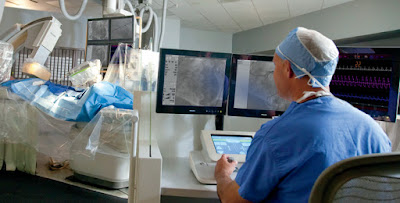Surgical robots, first introduced some 30 years ago are proving increasingly useful for many applications
Robotic‑assisted surgery involves a surgeon using a computer‑assisted electro-mechanical device to carry out complex and technically demanding medical procedures on a patient. The value of surgical robotic tools lies in their role as machines that extend the capabilities and precision of the surgeon, rather than ones that replace human skills.
Typically, a robotic surgical system consists of a camera arm and multiple mechanical arms with surgical instruments attached to them. The surgeon controls the arms while seated at a computer console which is located close to the operating table and provides a high‑definition, magnified, 3‑D image of the surgical site. The surgical robot’s computer software also filters out the surgeon’s hand tremors. For robotic radio surgery, non‑invasive technology can deliver high‑precision radiation therapy using continual image guidance technology and computer‑controlled robotic mobility.
Robotic surgical technology enables a surgeon to perform surgical movements that complement the natural range of motion of the human hand with greater precision, combined with high definition 3‑D visualization and magnification. Smaller incisions mean smaller scars, lower levels of blood loss and reduced trauma to the tissue involved, in comparison with conventional surgery.
 The smooth operation of a surgical robot relies on its electrical and mechanical components, sensors and computer software working together in harmony as well as on the skill and experience of the surgeon in charge.
The smooth operation of a surgical robot relies on its electrical and mechanical components, sensors and computer software working together in harmony as well as on the skill and experience of the surgeon in charge.IEC Standards vital as market expands
Growth in the worldwide robotic surgical systems market is being fuelled as emerging competitors challenge the dominance of established players by offering greater affordability and technological innovation.
The global market for surgical robot devices is forecast to expand from USD 3,2 billion in 2014 to USD 20 billion by 2021 “as next generation devices, systems and instruments are introduced to manage surgery through small ports in the body”, according to an April 2015 report by the US company Winter Green Research.
Medical robotics is a relatively new domain and relies on IEC International Standards to help ensure that the design and manufacture of parts meet the strictest requirements. The Subcommittees (SCs) and Working Groups (WGs) of IEC Technical Committee (TC) 62: Electrical equipment in medical practice, have been responsible for carrying out the bulk of the medical equipment standardization work required to formulate the IEC 60601 family of Standards. These cover the safety requirements for medical electrical (ME) equipment and medical electrical systems (MES) in current use.
IEC SC 62A: Common aspects of electrical equipment used in medical practice, formed Joint Working Group (JWG) 9 with ISO TC 184/SC 2: Robotics and robotic devices in June 2011; The Joint Working Group is now linked to ISO/TC 299/JWG 5. JWG 9’s remit is to “develop general requirements and guidance related to the safety of medical electrical equipment and systems that utilize robotic technology. The work encompasses medical applications (including aids for the disabled) covering invasive and non‑invasive procedures such as surgery, rehabilitation therapy, imaging and other robots for medical diagnosis and treatment”.
More than 80 experts are currently active in SC 62A/JWG 9, reflecting the importance of standardization for the sector. The IEC is also examining the still new and rapidly evolving issue of the incorporation of higher levels of autonomy in ME equipment and MES.
Touch me, heal me
Surgical robots incorporate sensors, for example to relay information or allow levels of force to be applied precisely. Manufacturers can build more reliable and efficient and safer sensors and micro-electro-mechanical systems (MEMS) thanks to International Standards prepared by IEC TC 47: Semiconductor devices, and IEC SC 47F: Micro-electro-mechanical systems.
New types of motors for surgical robots use ceramics and plastics rather than metal components, so robots using these materials are not affected by machines that emit magnetic waves, such as magnetic resonance imaging (MRI) scanners.
As robots become cheaper and more capable and the costs of sensors and software that heighten their capability continue to fall, new medical applications are expanding.
Minimally invasive robot instruments can both look and feel for cancer deep within the body, using a combined ultrasound probe and pressure sensor array. The latest radiation oncology robotic surgery devices, systems and instruments manage cancer surgery through radiation excision that eliminates open cutting in the body. Meanwhile, advances in robot‑assisted hip replacement surgery assist surgeons in ensuring the optimal alignment of artificial hip joints.
The next generation of robotic-assisted tools for surgeons incorporatesadvanced imaging and sensors to help doctors during operations. Researchers at Harvard are developing low‑cost, millimetre‑scale force sensors for robotic surgical tools, in which size is the biggest challenge, with the aim of eventually providing surgical robots with a sense of “touch”.
Other innovations include robotic suturing, a robot‑guided laser bone‑cutting device which offers more precise cutting geometries, and miniature snake‑like robots only a few millimetres in diameter.
A team led by the Hong Kong Polytechnic University is developing what it describes as the world’s first internally motorized minimally invasive surgical robotic system. It successfully carried out trials on animals using the prototype in December 2015.
The system, called the Novel Surgical Robotic System (NSRS), can be inserted through a single, small incision or even a natural orifice (incision‑less) and expanded inside the human body to perform various surgical operations. The small arms and micro‑motors that control them are then able to work on the body without requiring a large external machine to drive the tools.
The system is capable of haptic (tactile) feedback, allowing the surgeon operating it to feel the stiffness of tissues being manipulated by the instruments, a feature not available on current major robotic surgical systems.
Dr Louis Phee of Singapore’s Nanyang Technological University foresees a time when customizable micro/nano self‑configurable robots will be used for screening, surgery and biopsies. Nano‑robots are robots the size of a cell that could be introduced within blood flow to eliminate cancer cells or for tissue repair, among other uses.
Nanotechnology, the manipulation of matter on atomic and molecular scales, is a rapidly growing technology, but one that is still, to a great extent, in a developmental phase. However, it is seen as having great potential in medical applications. IEC TC 113 prepares International Standards for nanotechnology for electrical and electronic products and systems.
Dr Phee argues that “the real challenge for the future of robotics in surgery (and perhaps for surgery in general) is to go beyond the mere imitation and substitution by a robot of conventional procedures and surgical gestures, and rather to explore completely novel procedures made possible only by combining the use of robotic/mechatronic tools together with human surgical skills.”
Robot love
Medical robots have wider applications beyond surgery alone. For instance, robotic arms provide rehabilitation therapy for patients recovering from strokes and other neurological disorders. Autonomous mobile robot fleets can serve as medical workhorses, travelling for miles along hospital corridors carrying medical supplies, patients’ meals and other goods.
With people around the world living longer, and rising healthcare costs for the elderly overtaking tax revenues in many developed countries, one solution being mooted is that “cyberconscious” robots could replace human caregivers. In this scenario, care‑giving robots would assist their elderly charges with everyday tasks and remind them to take their medication.
The latest research extends to determining whether robots could make stronger social and emotional connections with people. The next generation of home‑care robots, for instance, could use visual cues such as tears, audio signals such as extended silence or barely audible speech, and physiological signs such as lowered temperature and raised blood pressure to assess moods among the elderly and could cheer them up during periods of unhappiness.
Support of Agency




Comments